Gangga Resort, Manado, IndonesiaContents of this Issue: Gangga Resort, Manado, Indonesia Caribbean Explorer II: Saba/St.Kitts The San Francisco Ocean Film Festival Wants Your Video Divemasters in American Waters The Devil is Not in the Details Editorial Office: Ben Davison Publisher and Editor Undercurrent 3020 Bridgeway, Suite 102 Sausalito, CA 94965 reefs, muck and luxury living from the January, 2011 issue of Undercurrent
Dear Fellow Diver: When the alarm clock went off at 4:30 a.m., I thought, “The diving better be tremendous.” I’d already flown 15 hours from JFK to Hong Kong, where I overnighted before a four-hour flight to Bali, then overnighted again. Now, in two hours I was to board a 6:30 a.m. flight to Makassar, Indonesia, with a five-hour layover in a stifling terminal, then fly another 90 minutes to Manado, where it would require an hour ride to the dock, where, at last we were to be greeted and taken for the last 30-minute boat ride to Gangga Island Resort. (Yes, there are a lot shorter ways to fly here, but our itinerary wasn’t one of those.)
Well, my buddy and I made it to the dock, but were greeted by no one. As dusk approached, a boat finally appeared in the distance and we finished the last leg of our journey in the rain. As you might imagine, I was interested in an adult beverage and bed, but as our gear was hauled to the bungalow, we were offered sandwiches and fresh coconut water. Then, off to the dive shop where Hanne Davi, the Danish resort manager, reviewed our c-cards and log books (husband Gaspare runs the Bali operation), collected our release forms and explained many dive details and the dive operation. Two-tank dives departed at 8:30 a.m., returning by 12:30 p.m. for lunch. All day three tank dives left at 8:00 a.m., return at 5:00 p.m. A 3:00 p.m. afternoon dive was available. She would try to accommodate requests for changes in our group, departure times or destinations. Seemed like good service to us. Gangga Island Resort and Spa lies
a few miles off North Sulawesi, smack
between the muck diving of Lembeh Strait
and the reef diving of Bunaken National
Marine Park, making it ideal for those
who want to dive both areas from luxurious
land-based accommodations. Fifteen
two-unit bungalows with a capacity of
two adults and two children in each unit, are scattered along a winding stone path
leading to the dining hall and lounge. Built from dark native woods, the bungalows were light and airy, with large curtained windows, high ceilings with overhead fans, and fresh flowers. Our comfortable king-sized bed had mosquito netting, which proved unnecessary as we never met a single mozzy. The A/C kept us cool in August; some guests didn’t use it. The large bathroom sported a long counter area, bath products and fluffy towels. Soft drinks and beer were in the mini fridge and a five-gallon jug of filtered water was filled daily. Regardless, a few guests had minor bouts of Suharto’s Revenge. The small TV offered Indonesian soap operas, HBO, and ESPN via satellite. A huge open shower was next to a large window so we could wave at folks on the beach while washing off the salt. Being European, they didn’t seem to mind.
After a thorough boat briefing on our first day, which included detailed reef sketches on a white board, I donned my aluminum 80, backrolled and dropped down at Aer Benua. A swift current zipped my buddy and me along a wall dusty with sediment from recent rains. All of sudden the current stopped. Then it pushed me down a few feet to where it picked up again and we were off to the races. At 1500 psi, I ascended with my buddy and others to the coral garden at 20 feet, but now fought the current as it ran in the opposite direction. I managed to hang on the reef long enough to peer at a wire goby, then winged back to the boat, where I handed up my fins and BCD, and climbed up the short ladder and reported my depth and time. (We were asked not to exceed 130 feet, but there was no practical reason to dive that deep; all the cool stuff was shallower.) The rides to sites in their 45-foot partially covered boat ranged from 20 to 45 minutes. We glided on flat seas past emerald islands against a background of volcanic cones. Underwater, the guides, once satisfied with our skills, were never overbearing. They pointed out critters with stainless steel rods, without hassling the sea life. Photographers could stop and shoot without interference. Though we never had more than eight divers onboard, the Indonesian dive staff created two groups presumably separated by skill level, but it usually was one group of Italians and a second group of everybody else. The two groups frequently surfaced far apart, but the boat crews were always watchful. One day we were joined by a Mexican fellow who flailed around frantically in the current trying to deal with 20 pounds of lead, until he ran low of air and had to surface. We stayed down. On days when it was just the two of us and the Italians, we had our own private DM. My partner speaks rudimentary Italian and the surface intervals were friendly times, especially when local ladies came onboard to hawk shell jewelry and T-shirts. Sanchiko Point in Bunaken was home
to tens of thousands of red-toothed
trigger fish and a large school of
pyramid butterflies. A small group of
batfish beckoned me deeper, where a
few jacks flitted by and a Teira batfish
fled to a coral head. At Fukui
Point I drifted easily among thousands
of damsels, and more pyramid butterflies.
At Lekuan II, I dropped alone to 95 feet and swam along a sheer wall with large stands of black and orange coral trees, reveling in 82°F water and 100-foot vis. A white-tip reef shark passed in the opposite direction and a hawksbill in a hole watched me kick by. Nirvana, indeed. Sahaung was Crinoid Central, where the feathery and colorful critters were arrayed everywhere: green with yellow, magenta and black, red with yellow, multiple shades of blue. Baby white tips clustered under a dead table coral while a bumphead parrot grazed alone. On the second day I switched to an aluminum 100 and 32% Nitrox. There were also 62s available, and plenty of spares stowed below the deck so you could dive a 100 on the first deep dive, and switch to an 80 for a shallower second plunge. They analyzed the Nitrox, but I always checked my own fill. Midweek the Nitrox system failed and I had to go back to air. After diving, gear was rinsed and hung up to dry, packed and set up on the boat the next morning. But the staff wasn’t perfect. Once I found my Scubapro Mark 25 upside down on the tank. Another time the o-ring on my tank failed and DM Donal tried to fix it while I was bobbing on the surface, but the leak only got worse. I had to get out of the water, holding up the entire group. After three dives and a one-hour full body massage ($35) at the Pasung Spa, I slid into a relaxed evening mood, hungry as a bear. So having to wait for the rigid meal times was torture. Other than the two weekly BBQs, and two lunch buffets, lunch and dinner were at 1 p.m. and 8 p.m. respectively, and ordered from menus. I suspect the late dinner time accommodates the mostly European clientele, many of whom appeared at dinner in collared shirts and dresses, not the typical T- shirts and shorts worn by us casual Americans in most dive resorts. There is no room service, and no snacks for sale, so PYOP (Pack Your Own Pringles). Before dinner, no chatty crowd swapped dive tales at the watering hole. Guests ordered their drinks and drifted off to flip through books from the library, watch videos, shoot pool or link to the free Wi-Fi. That left two starved Yanks at the bar munching free peanuts and fish snacks while waiting for 8 p.m. Thankfully, food was scrumptious: continental and Indonesian, with choices of meat, fish, chicken or pastas, preceded by soup, salad or hot appetizer, and followed by small portions of cake, pie or ice cream. Aussie and Kiwi wines were available, as were Heineken and local brews served in frosted mugs, and the bartender could even mix margaritas and mojitos. (Breakfast was buffet-style, with eggs, pancakes, cereals, toast and fruit.)
The dive package included a night dive off Lihaga, a small island where Mandarin fish mate. Descending to 35 feet at dusk, we hunkered down in rubble near a three-foot high coral ledge. As if on cue, at 6 p.m. the outrageously colored little buggers emerged from the coral and crept around the sea bed, some within inches of my hands, before swimming off on other business. One pair swam up bellyto- belly right in front of us and darted apart, leaving a small cloud of eggs and sperm to the mercy of the sea. The show is guaranteed; a German couple we met got skunked on their Mandarin dive, so the management offered them a second try at no cost. Management makes a significant investment in the local villagers, providing jobs and training. Some staff has even been sent to Italy to learn Italian (most guests were Italian). It’s a friendly staff, made more so if you got to know them by name and smiled. Your breakfast coffee will arrive without asking, there will be more ice in your water glass, and the bartender may even offer you a taste of the local homemade popskull he keeps hidden away. Caution is advised. Staff assisted us with flight confirmation and emails. This attention to detail brings divers back again and again. One was on his tenth visit, and said he preferred Gangga to Wakatobi because of the easy-going divemasters. Our last dive was at Alpha Omega, a cove in front of a classic South Seas island with thatched hut and resident dugong. Strictly a muck dive, it offered all the macro critters we hadn’t seen yet: Ambon stonefish, pygmy pipe seahorse, fire dartfish, leaf razor fish, fringed dragonet, long-horned cow fish, flying gurnards, marbled snake eel, a little sea moth, and according to my partner’s log, a “wrasse with a big thing on its head,” which turned out to be a pavo razorfish. Scientists have recently reported extensive coral bleaching throughout Southeast Asia, but on our dives most reefs were unaffected. Except for trips to Bunaken, we saw no sharks or rays, but even two pelagic-freaks like we had to admit the macro life was stunning. At Rainbow Reef, pygmy sea horses justified the use of our magnifying glasses. A white frog fish walked across a coral head, and we saw our first-ever blue ribbon eel. One downer -- the ocean is littered with floating trash on top and debris at depth. The concept of using trash receptacles hasn’t made it to Indonesia yet. The mola mola I thought I saw turned out to be a black garbage bag drifting by at 100 feet. The diving did proved tremendous. We loved the scenery below and above. If you are a muck-lover and don’t want a live-aboard, this could be your place, even though park entry fees don’t pay for trash cleanup. – T.D.
|

I want to get all the stories! Tell me how I can become an Undercurrent Online Member and get online access to all the articles of Undercurrent as well as thousands of first hand reports on dive operations world-wide
| Home | Online Members Area | My Account |
Login
|
Join
|
| Travel Index |
Dive Resort & Liveaboard Reviews
|
Featured Reports
|
Recent
Issues
|
Back Issues
|
|
Dive Gear
Index
|
Health/Safety Index
|
Environment & Misc.
Index
|
Seasonal Planner
|
Blogs
|
Free Articles
|
Book Picks
|
News
|
|
Special Offers
|
RSS
|
FAQ
|
About Us
|
Contact Us
|
Links
|
3020 Bridgeway, Ste 102, Sausalito, Ca 94965
All rights reserved.

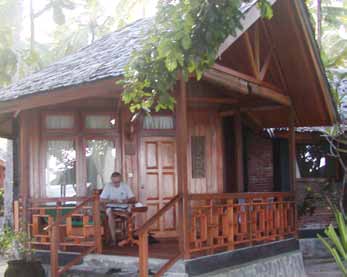
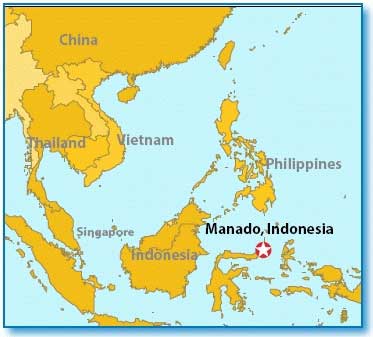 We could enjoy the exceptional sea view
from our porch lounges in privacy from residents bunked on the other side of a
common wall. If I wanted to snooze beneath a palm tree on the beach, I had a personal
lounge with foam pads. At the price of a 10-minute walk from the dive shop,
being billeted in the next to last building meant few passersby and no kitchen
noise.
We could enjoy the exceptional sea view
from our porch lounges in privacy from residents bunked on the other side of a
common wall. If I wanted to snooze beneath a palm tree on the beach, I had a personal
lounge with foam pads. At the price of a 10-minute walk from the dive shop,
being billeted in the next to last building meant few passersby and no kitchen
noise. 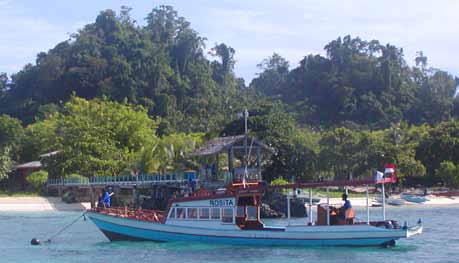
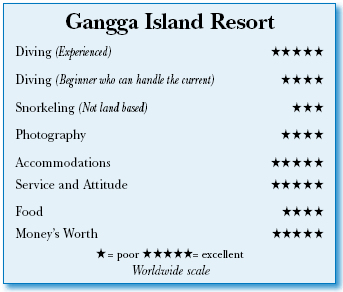 Lettuce and staghorn corals
were dotted with anemones housing
Clark’s and skunk anemone fish.
Hawksbill turtles settled down for
photos or swam along slowly with us.
Photographers were in the minority.
Rinse tanks were beverage coolers that
couldn’t accommodate the larger rigs,
and any adjustments had to be made on
the benches that lined either side of
the boat.
Lettuce and staghorn corals
were dotted with anemones housing
Clark’s and skunk anemone fish.
Hawksbill turtles settled down for
photos or swam along slowly with us.
Photographers were in the minority.
Rinse tanks were beverage coolers that
couldn’t accommodate the larger rigs,
and any adjustments had to be made on
the benches that lined either side of
the boat. 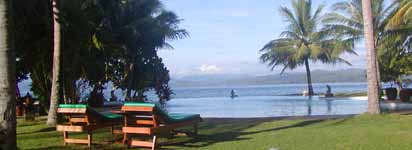
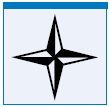 DIVER’S COMPASS: From NYC, Singapore Airlines flies to Singapore
with fewer hassles than I faced. As little as $1,523 with an
8-hour layover in Frankfurt (get a hotel room in the airport)
and a 2½ hour layover in Singapore. From JFK there are flights
to Singapore connecting to Manado as low as $1,329; from LAX you
can go without layovers for as little as $1,184 . . . We booked
the resort through Island Dreams. Helpful and experienced, their
package rates beat those on Gangga’s website. Through March, a
seven-night package with five dives is $1,798.00; last August we paid the high
season price of $2,104 . . .
DIVER’S COMPASS: From NYC, Singapore Airlines flies to Singapore
with fewer hassles than I faced. As little as $1,523 with an
8-hour layover in Frankfurt (get a hotel room in the airport)
and a 2½ hour layover in Singapore. From JFK there are flights
to Singapore connecting to Manado as low as $1,329; from LAX you
can go without layovers for as little as $1,184 . . . We booked
the resort through Island Dreams. Helpful and experienced, their
package rates beat those on Gangga’s website. Through March, a
seven-night package with five dives is $1,798.00; last August we paid the high
season price of $2,104 . . . 